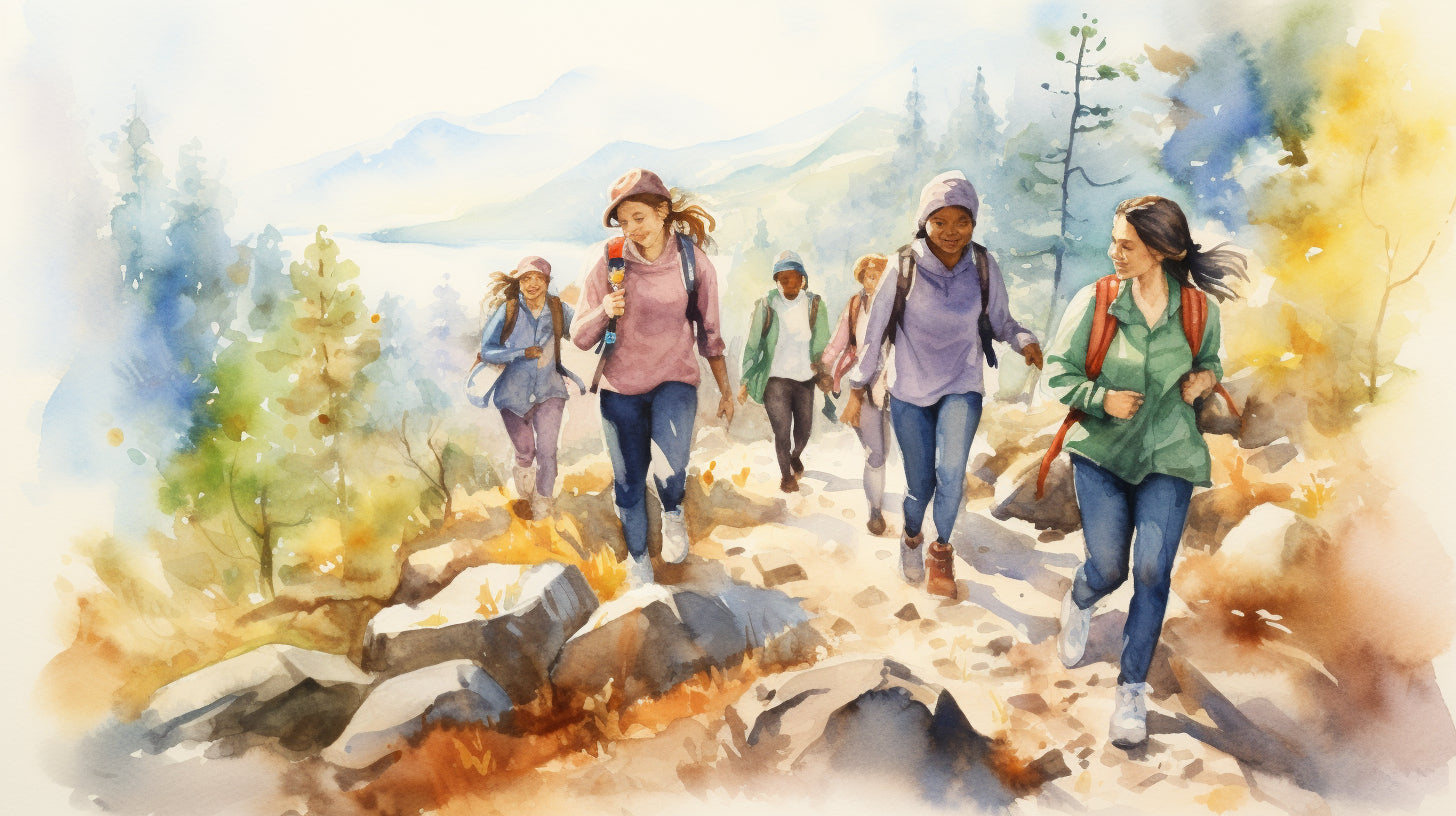Welcome, stay-at-home moms! Are you ready to embark on exciting outdoor adventures with your little ones? If you've been spending most of your time indoors, it's time to step outside and explore the wonders of nature. Outdoor adventures not only provide a refreshing change of scenery, but they also offer numerous benefits for both you and your children.
In this guide, we will explore the world of outdoor adventures and discuss how to plan them safely. We'll also dive into the many benefits that these experiences can have on your children's development. So grab a cup of coffee, put on your hiking boots, and let's get started on this thrilling journey!
Disclaimer: While we encourage outdoor exploration, please ensure you comply with any local regulations or restrictions related to COVID-19 or other safety concerns.
Understanding Outdoor Adventures
Whether you're an experienced outdoor enthusiast or just beginning to explore the world of outdoor adventures, it's important to have a good understanding of what outdoor adventures are all about. From hiking and camping to kayaking and mountain biking, outdoor adventures offer a range of thrilling experiences that allow you to connect with nature and challenge yourself. In this section, we'll delve into the definition and importance of outdoor adventures, as well as explore the different types of outdoor activities you can engage in.
Definition and Importance
Outdoor adventures refer to recreational activities that take place outdoors in natural environments such as forests, mountains, rivers, and lakes. These activities are typically physically demanding and involve a certain level of risk, making them exciting and exhilarating for those who embark on them.
Engaging in outdoor adventures provides numerous benefits for individuals of all ages. From a mental health perspective, being in nature helps reduce stress levels and improve overall well-being. Outdoor activities also provide an opportunity to disconnect from the digital world, allowing you to reconnect with yourself and your surroundings.
Types of Outdoor Adventures
Outdoor adventures come in a variety of forms, catering to different interests and skill levels. Here are some popular types of outdoor adventures:
- Hiking: Hiking involves walking on trails or paths in natural landscapes. It offers an opportunity to explore scenic views, discover hidden gems, and enjoy the serenity of nature. Hiking can range from easy, leisurely walks to challenging, multi-day treks.
- Camping: Camping allows you to immerse yourself in nature by spending a night or more in a tent, RV, or cabin. It provides an opportunity to bond with family and friends around a campfire, participate in outdoor activities, and enjoy starry nights.
- Water Sports: If you're a water enthusiast, you can indulge in various water sports such as kayaking, paddleboarding, surfing, and fishing. These activities not only provide a fun and refreshing experience but also allow you to explore different bodies of water.
- Mountain Biking: For thrill-seekers who enjoy cycling, mountain biking is an exciting option. It involves riding on off-road trails with rugged terrains, providing an adrenaline-pumping experience.
- Climbing and Mountaineering: If you have a knack for heights and challenges, climbing and mountaineering might be your cup of tea. These activities involve scaling rocks, cliffs, or mountains, pushing your physical and mental limits.
Remember, outdoor adventures can be tailored to your preferences and abilities, so don't be afraid to try new activities and explore different aspects of the outdoors. It's all about finding what resonates with you and embracing the exhilaration that comes with it!
How to Plan Outdoor Adventures
Planning outdoor adventures can be an exciting and fulfilling experience, especially when you're a stay-at-home mom looking to create memorable moments for your family. However, it can also be overwhelming if you're unsure where to start. Don't worry, we've got you covered! Here are some essential steps to help you plan your next outdoor adventure like a pro:
Identifying the Right Adventure
Before you begin planning, it's important to consider the interests, preferences, and abilities of your family members. Ask yourself:
- What type of outdoor activity does my family enjoy? This could be hiking, camping, biking, or even wildlife spotting.
- How physically fit is everyone? Choose activities that are suitable for everyone's fitness levels.
- Are there any age restrictions or safety concerns you need to keep in mind?
By answering these questions, you can narrow down your options and focus on activities that are both enjoyable and achievable for everyone involved.
Assembling Necessary Equipment
Once you have decided on the type of outdoor adventure, it's time to gather the necessary equipment. Make a checklist of the items you will need for the trip, such as:
- Camping gear (tent, sleeping bags, cooking utensils)
- Hiking gear (appropriate footwear, backpacks, navigation tools)
- Safety equipment (flashlights, first aid kit, emergency supplies)
- Clothing suitable for the weather conditions and activity (layering is always a good idea!)
Don't forget to check if you already own any of the items or if you need to borrow or purchase them. Planning and packing the right equipment will ensure that you have a comfortable and safe adventure.
Pro Tip: Always check the weather forecast for your chosen adventure location. This will help you pack the appropriate clothing and gear to stay comfortable and protected.
Setting an Adventure Time
Choosing the right time for your outdoor adventure is crucial for a successful experience. Consider the following factors when deciding on the ideal time:
- Weather conditions: Avoid extreme weather conditions such as heavy rain or scorching heat.
- Availability: Check everyone's schedules to find a suitable time where all family members can participate.
- Seasonal considerations: Certain activities may be more enjoyable during specific seasons. For example, skiing in winter or beach camping in summer.
Once you have determined the best time for your adventure, mark it on your calendar and start the countdown!
Planning an outdoor adventure doesn't have to be complicated. By following these steps and taking the time to prepare, you can ensure that your family has an enjoyable and safe experience. So, get ready to create unforgettable memories in the great outdoors!
"In every walk with Nature, one receives far more than he seeks." - John Muir
Ensuring Adventure Safety
When it comes to outdoor adventures, safety should always be a top priority. Whether you're planning a hiking trip, a camping excursion, or a day at the beach, taking the necessary precautions can help ensure that you and your family have a safe and enjoyable experience. Here are some tips to help you ensure adventure safety:
Basic Safety Measures
- Research and Plan: Before embarking on an outdoor adventure, make sure to research and plan accordingly. Familiarize yourself with the area, including any potential risks or hazards that may be present. Check weather conditions, trail conditions, and any safety guidelines provided by parks or outdoor organizations.
- Tell Someone: Always let someone know your plans. Before heading out, tell a family member or a friend where you're going and when you expect to be back. This way, if anything goes wrong, someone will know where to find you.
- Pack the Essentials: Make sure to pack essential items such as a first aid kit, a map, a compass, extra water, and snacks. Being prepared with the right supplies can help you handle unexpected situations.
Emergency Preparedness
- Know Basic First Aid: Familiarize yourself with basic first aid techniques. Take a first aid course or read up on CPR, treating minor injuries, and recognizing the signs of more serious conditions such as heatstroke or hypothermia.
- Carry a Communication Device: Have a reliable form of communication with you, such as a fully charged cell phone or a two-way radio. This can be crucial in case of emergencies or if you need to call for help.
- Learn to Read Maps and Use a Compass: Knowing how to navigate using a map and compass can be invaluable when you're out in the wilderness. Brush up on your navigation skills to avoid getting lost.
Discussing Safety Measures with Children
- Teach Your Children about Basic Safety: Before heading out on an adventure, have a conversation with your children about basic safety measures. Teach them about staying close to you, the importance of wearing appropriate clothing and gear, and what to do in case they get separated from you.
- Set Rules and Boundaries: Establish clear rules and boundaries for your children to follow during outdoor adventures. Talk to them about the importance of staying on marked trails, not wandering off alone, and respecting nature.
- Encourage Open Communication: Create an environment where your children feel comfortable voicing their concerns or asking questions about safety. Encourage them to speak up if they see something that doesn't feel right or if they feel unsafe.
Remember, adventure safety is a continuous process. Stay updated on safety guidelines and recommendations, and always prioritize the well-being of yourself and your family. By taking the necessary precautions and being prepared, you can enjoy your outdoor adventures with peace of mind.
Benefits of Outdoor Adventures for Children
Outdoor adventures can provide countless benefits for children, helping them grow and develop in various ways. As a stay-at-home mom, you have a unique opportunity to expose your children to the wonders of the great outdoors and all the positive experiences that come with it. Here are some of the key benefits of outdoor adventures:
1. Physical Development
Outdoor adventures encourage physical activity and help children develop their motor skills. Whether it's climbing a tree, running in the park, or riding a bike, these activities improve balance, coordination, and strength. Regular physical activity also contributes to healthy growth and development, reducing the risk of childhood obesity and related health issues.
2. Emotional and Social Development
Outdoor adventures provide children with opportunities to socialize and interact with others. Engaging in group activities such as hiking or team sports helps children develop essential social skills like communication, teamwork, and problem-solving. Being in nature also has a calming effect on children, reducing stress and anxiety and promoting emotional well-being.
3. Cognitive Development
Exploring the outdoors stimulates a child's curiosity and encourages them to ask questions, make observations, and think critically. The natural environment offers endless opportunities for learning, from identifying different plants and animals to understanding the science behind natural phenomena. Outdoor adventures also foster creativity, imagination, and independent thinking.
"Outdoor adventures can provide countless benefits for children, helping them grow and develop in various ways."4. Environmental Awareness and Stewardship
By spending time in nature, children develop a deeper understanding and appreciation for the environment. They learn about the importance of conservation and the impact they can have on the natural world. This early exposure to nature often leads to a lifelong commitment to environmental stewardship and sustainable practices.
5. Confidence and Self-Esteem
Outdoor adventures challenge children to step outside their comfort zones and overcome obstacles. Whether it's conquering a fear of heights or successfully navigating a hiking trail, each achievement boosts their confidence and self-esteem. These experiences teach children that they are capable of overcoming challenges and instill a sense of pride in their abilities.
6. Enhanced Senses and Curiosity
The outdoors stimulate all of a child's senses, from the smell of fresh air to the sound of birds chirping. Exploring nature encourages children to engage with their surroundings, develop a keen sense of observation, and appreciate the beauty of the natural world. This heightened awareness fosters a sense of curiosity and a lifelong love for learning.
"Outdoor adventures challenge children to step outside their comfort zones and overcome obstacles."By understanding the benefits of outdoor adventures for children, you can prioritize and plan for these activities in your family's routine. Remember, it's not just about the fun and excitement of outdoor adventures; it's about providing your children with valuable experiences that contribute to their overall growth and development. So, grab your hiking boots, pack a picnic, and embark on memorable outdoor adventures with your little ones!
Overcoming Challenges in Outdoor Adventures
Embarking on outdoor adventures can be an exciting and enriching experience for both children and parents. However, it is essential to be prepared for any challenges that may arise during these adventures. From unforeseen weather changes to potential hazards, here are some tips to help you overcome these obstacles and ensure a safe and enjoyable time outdoors.Dealing with Unforeseen Weather Changes
One of the primary challenges of outdoor adventures is dealing with unpredictable weather conditions. To overcome this challenge:- Stay informed: Check the weather forecast before heading out and stay updated throughout your adventure using weather apps or a portable weather radio.
- Dress appropriately: Dress in layers, so you can adjust your clothing as the weather changes. Wear waterproof and insulated gear to protect against rain, wind, and cold temperatures.
- Pack essential gear: Carry extra clothing, blankets, and rain gear in case of sudden weather changes. It's better to be overprepared than caught off guard.
- Find shelter: If the weather suddenly takes a turn for the worse, seek shelter in a sturdy building, car, or a tent if you have one. Make sure to set up your tent in a safe location away from trees or potential hazards.
Handling Insects and Other Potential Hazards
When you're out in nature, you may encounter insects, wildlife, or other potential hazards. Here's how you can handle these challenges:- Use bug repellents: Apply insect repellents with DEET or other recommended ingredients to protect against mosquito bites and other insect-related discomforts.
- Be aware of wildlife: Educate yourself and your children about the wildlife in the area you're visiting. Teach them to observe from a safe distance and not to approach or feed wild animals.
- Protect against ticks: Wear long pants, socks, and closed-toe shoes to minimize exposure to ticks. After your adventure, thoroughly check your body and clothing for ticks, and remove them carefully.
- Be cautious of poisonous plants: Familiarize yourself with poisonous plants like poison ivy, oak, or sumac, and teach your children to identify and avoid them.
Ensuring Hygiene and Nutrition on the Go
Maintaining proper hygiene and nutrition is crucial, even when you're out adventuring. Here are some tips to help you stay clean and well-fed:- Pack hand sanitizers: Carry hand sanitizers and use them frequently, especially before meals or snacks. If water is available, opt for washing hands with soap and water.
- Bring proper snacks and meals: Pack healthy snacks like fruits, nuts, and granola bars. Prepare meals that are easy to transport and won't spoil quickly.
- Stay hydrated: Hydration is key, particularly during physical activities. Carry an adequate supply of water, and encourage your children to stay hydrated as well.
- Dispose of waste properly: Practice Leave No Trace principles by packing out any trash and disposing of waste appropriately. Use designated restrooms or dig a hole for human waste, following the guidelines of the area you're visiting.
Resources for Stay-at-Home Moms
As a stay-at-home mom, you might be wondering where to find the best resources and support for planning outdoor adventures with your children. Luckily, there are plenty of resources available to help you make the most of your time outdoors. Here are a few that are worth exploring:
Online Blogs and Websites
- Adventure Mom: Adventure Mom is a blog that caters specifically to moms who love outdoor adventures. They offer tips, advice, and inspirational stories about various outdoor activities. From hiking to camping and everything in between, Adventure Mom has got you covered.
- The Outbound Collective: The Outbound Collective is an online resource that connects outdoor enthusiasts with adventure ideas, reviews, and recommendations. They have a section specifically dedicated to family-friendly adventures, making it a great place to gather ideas for your next outing.
- REI Co-op Journal: REI Co-op Journal is an online publication that covers a wide range of outdoor topics, including adventure planning and safety. They offer informative articles and guides that can help you navigate the world of outdoor adventures with your little ones.
Community Groups and Networks
- Moms Meet: Moms Meet is a community that brings together like-minded moms who share a passion for healthy living and outdoor adventures. Through their website and local meetups, you can connect with other moms in your area who enjoy exploring the outdoors with their children.
- Hike it Baby: Hike it Baby is a nonprofit organization that aims to get families outdoors and connected with nature. They have local chapters all across the United States and offer organized hikes and outdoor playdates for families with young children. It's a wonderful opportunity to meet other moms and kids who love exploring the great outdoors.
- Meetup: Meetup is a platform that brings people together based on shared interests. You can search for outdoor adventure groups in your area and join them for hikes, camping trips, and other outdoor activities. It's a fantastic way to meet other moms who enjoy outdoor adventures and find support and inspiration.
Outdoor Adventure Apps
- AllTrails: AllTrails is a popular app that helps you discover and navigate trails for hiking, biking, and running. It provides detailed trail maps, reviews, and photos, making it easier for you to find family-friendly trails in your area. You can even save your favorite trails for future adventures.
- Geocaching: Geocaching is a real-world outdoor treasure hunting game that uses GPS-enabled devices. It's a fun way to explore the outdoors with your kids and adds an element of adventure to your outings. The Geocaching app helps you find hidden caches near your location and provides clues to help you locate them.
- PlantSnap: If you're interested in teaching your children about plants and wildlife during your outdoor adventures, PlantSnap is a handy app to have. It uses image recognition technology to identify plants and flowers, allowing you to learn more about the plants you encounter on your hikes.
These are just a few of the many resources available to stay-at-home moms who want to plan outdoor adventures with their children. Remember, the most important thing is to have fun and create lasting memories with your little ones. So, get out there, explore, and enjoy the wonder of nature together!
Conclusion
Outdoor adventures are a wonderful way to create lasting memories with your family and provide valuable learning experiences for your children. By planning and preparing for your outdoor adventures, prioritizing safety, and embracing the benefits of nature, you can ensure that your family has a fun and rewarding time.
Remember, safety should always be your top priority when embarking on outdoor adventures. Be prepared with the necessary equipment, educate yourself and your children about potential hazards, and have a plan in place for emergencies. By taking these precautions, you can minimize risks and enjoy your adventures with peace of mind.
Additionally, outdoor adventures offer numerous benefits for children's development. From physical fitness to emotional and social skills, these experiences can help your children grow and thrive. Encourage their curiosity, support their exploration, and watch as they blossom in the great outdoors.
As a provider of personal safety products, Empowered by Ashley understands the importance of staying safe, reassured, and secure. We offer a range of personal safety alarms designed to deter attackers and provide peace of mind. Visit our website here to explore our best-selling products and prioritize the safety of you and your loved ones.
So, gather your family, embrace the great outdoors, and create memories that will last a lifetime. Happy adventuring!
Frequently Asked Questions
-
What are some outdoor adventure activities recommended for stay-at-home moms?
Some recommended outdoor adventure activities for stay-at-home moms include hiking, camping, biking, kayaking, and nature walks.
-
How can stay-at-home moms ensure their safety during outdoor adventures?
To ensure safety during outdoor adventures, stay-at-home moms should always research and plan their activities in advance, dress appropriately, stay hydrated, bring essential safety equipment, inform someone about their plans, and be aware of their surroundings.
-
Are there any safety precautions stay-at-home moms should take while hiking alone?
When hiking alone, stay-at-home moms should tell someone about their planned route, carry a map and compass, bring a whistle or signaling device, be aware of wildlife in the area, and avoid hiking during severe weather conditions.
-
What are some essential items stay-at-home moms should pack for a camping trip?
Some essential items stay-at-home moms should pack for a camping trip include a tent, sleeping bags, camping stove, cooking utensils, flashlight, first aid kit, insect repellent, and extra clothing.
-
How can stay-at-home moms encourage outdoor adventures for their children?
Stay-at-home moms can encourage outdoor adventures for their children by planning family outings, organizing nature scavenger hunts, teaching them about wildlife and nature, and providing them with appropriate outdoor gear and equipment.




















Leave a comment
This site is protected by hCaptcha and the hCaptcha Privacy Policy and Terms of Service apply.